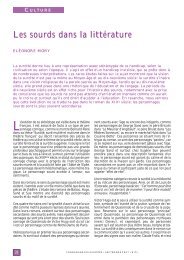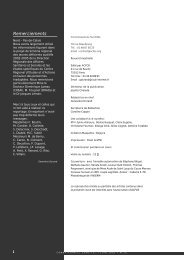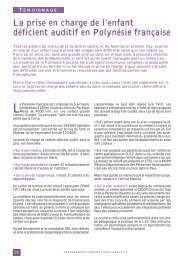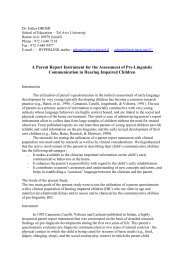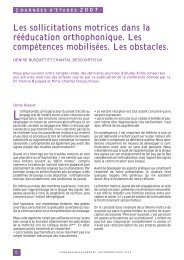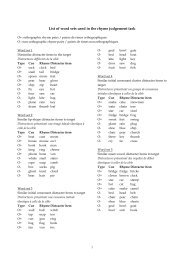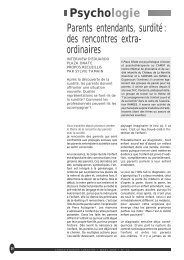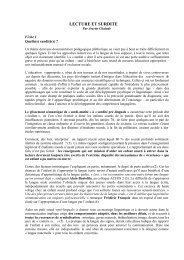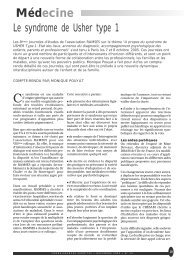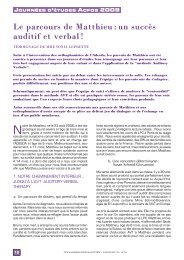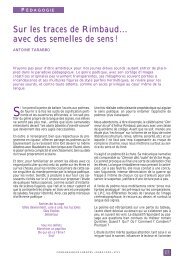Assessing and Understanding Deaf Learners - ACFOS
Assessing and Understanding Deaf Learners - ACFOS
Assessing and Understanding Deaf Learners - ACFOS
Create successful ePaper yourself
Turn your PDF publications into a flip-book with our unique Google optimized e-Paper software.
<strong>Assessing</strong> <strong>and</strong> Underst<strong>and</strong>ing <strong>Deaf</strong> <strong>Learners</strong> 5the same time foster language <strong>and</strong> cognitive development, through a variety of similar strategies.When they point to an interesting thing, they name it, <strong>and</strong> frequently point at it again, thushelping to connect the name the with the thing. They do not begin a signed utterance until thechild is actually paying attention (something difficult for hearing parents to adjust to), so that thechild does not have to switch attention back <strong>and</strong> forth. <strong>Deaf</strong> parents slow the rate ofcommunication relative to hearing parents, allowing their children more time to underst<strong>and</strong>messages, <strong>and</strong> they use shorter utterances. As with pointing, deaf parents also put important ornew information at both the beginning in the end of an utterance, ensuring that a childunderst<strong>and</strong>s the topic of discussion (Mohay, Milton, Hindmarsh, & Ganley, 1998). Importantly,these are not just factors of importance to parents, but essential aspects of communication foranyone involved in caring for, teaching, or evaluating deaf children.Taken together, these visually-based strategies do more than just gain attention <strong>and</strong>support communication: they form the basis for learning <strong>and</strong> development in other domains. Anumber of early intervention programs thus are starting to incorporate training for (hearing)parents in such techniques, Generally, children who are enrolled in early intervention programshave effective communication <strong>and</strong> affective bonds with their mothers, <strong>and</strong> who use signlanguage tend to show the greatest gains in development <strong>and</strong> early academic success (Calderon& Greenberg, 1997). While deaf parents’ intuitive parenting strategies may be particularlysupportive in these domains, with appropriate intervention, hearing parents can do this just aswell as deaf parents.AttentionAnother obvious difference between deaf <strong>and</strong> hearing children has recently gainedrecognition as worth investigating, albeit in a way distinct from what might be expected: theavailability of auditory information. The development of visual attention skills is clearlyimportant for deaf children. Discussions of visual attention in hearing children usually includethe role played by auditory information, <strong>and</strong> there now some evidence that there must be someconsideration of its contribution for hard of hearing <strong>and</strong> some “deaf” individuals as well.A variety of studies have shown that the developmental pattern of visual attention amongyoung deaf <strong>and</strong> hearing children is very similar. We know, for example, that parents (deaf orhearing) who use more visual communication with their (deaf or hearing) children are morelikely to have children who are better at maintaining joint visual attention with them (Spencer,2000). At the same time, auditory information — both elaborating about an object of attention<strong>and</strong> reinforcing the child for attending to it — appears to encourage hearing children to attend tothose objects longer. Unlike hearing children, who can attend to an object visually whileattending to parental language auditorally, deaf children have to switch their attention betweenan object of interest <strong>and</strong> the person who is communicating about the object. That switchingclearly has an impact on both the amount of information that might be communicated <strong>and</strong> thetime available to engage in visual exploration. It also affects a child’s interest in objects <strong>and</strong>communication as well as their willingness to attend to those who interrupt them (Harris,Clibbens, Chasin, & Tibbitts,1989).At least at preschool age, both deaf <strong>and</strong> hearing children appear to be equally good atmaintaining visual attention (Waxman & Spencer, 1997; but see Spencer, 2000, for variation as afunction of communication strategies of deaf <strong>and</strong> hearing mothers). By age 6, however, deafchildren tend to be more prone to visual distraction than hearing children (e.g., Quittner, Smith,




